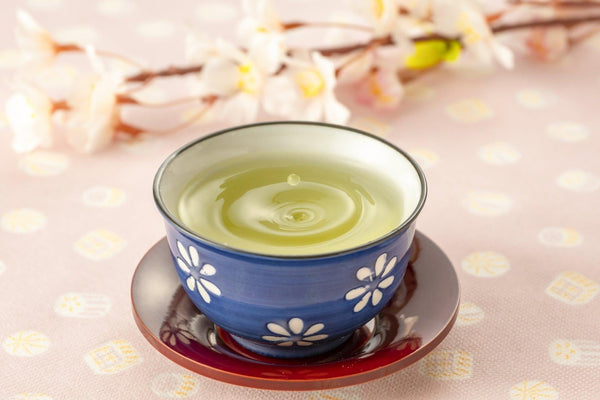
Jump to:
Green tea, also called ryokucha in Japanese, is one of the most beloved beverages in Japan. It has been enjoyed for centuries and holds a lot of importance in the culture. Not only is it consumed by people around the country daily, but it can also be found just about anywhere in Japan. From specialty tea shops to convenience stores, wherever you decide to purchase green tea in Japan you are guaranteed a delicious and authentic product. Moreover, green tea is known for having a unique aroma and flavor that distinguishes it from other countries' green tea.
You might be wondering, what makes Japanese green tea so unique? What even is Japanese green tea in the first place? We’ll go over both of those questions and more, as we discover the world of Japanese green tea in this article.
What is Japanese Green Tea?

While green tea is a very common drink in Japan, it may come as a bit of a surprise (or maybe not) that the culture of green tea was brought over from China. The history of tea culture in Japan dates all the way back to the Nara period (710-784 AD) when an abundance of Chinese influence was brought into the country. However, Japanese green tea culture really began flourishing during the Kamakura period (1192 -1333) when the cultivation of tea leaves became common practice.
Since Japanese green tea is made from the same variety of tea leaves used in China, which are leaves of the Camellia Sinensis plant, what exactly makes it Japanese? The difference lies within the heating process of the leaves, which results in Japanese green tea having a distinct flavor, aroma, and even color than Chinese green tea.
Japanese green tea, in particular, is known for being “non-fermented tea” because the tea leaves are heat-treated shortly after being picked. This cultivation method is what gives Japanese green tea its bright, signature green color.
Where Is Japanese Green Tea Made?
There are many places throughout the country that specialize in producing green tea. However, 70% of green tea production in Japan takes place in Shizuoka, Kagoshima, Mie, Kyoto, and Fukuoka. If you drink green tea in Japan, it will likely have been manufactured in one of those five prefectures.
How Is Japanese Green Tea Made?

The process of making flavorful Japanese green tea is quite long and particular. After the tea leaves are picked, they go through a very specific process. The process is as follows: Picking → steaming → kneading & drying → sorting → burning → gogumi → distribution
Picking
To make green tea, you of course need tea leaves! Tea leaves are picked by hand or by machine, depending on the cultivation site. The period for tea leaf picking also depends on which area they are harvested in. For example, Kagoshima, which is located on Kyushu island in the southern part of Japan has a warm climate. That means that the tea leaves can begin being harvested earlier, around early spring or late March to early April. On the other hand, Shizuoka, which is close to Tokyo, has a bit of a cooler climate than Kagoshima. To account for the cooler weather patterns, tea-leaf picking begins around mid-spring or late April.
Steaming
The tea leaves are steamed (or heat treated) right after they are freshly picked to prevent them from fermenting. This is really what gives green tea its fresh, zingy flavor. Fermentation in tea leaves happens almost instantaneously after they are picked, due to the oxidation enzymes present in the leaves themselves. Thus, tea leaves are steamed within 20 hours of being picked.
Kneading/Drying
After the tea leaves are steamed, they are rubbed together so that the inner fibers can loosen. The drying process also removes the moisture from the tea leaves, which will cause them not to spoil. They also develop their unique flavors at this stage. Tea leaves that reach a moisture content of around ¼ or ⅕ their weight are categorized as crude tea. They have a different flavor profile than fully dried-out tea leaves.
Sorting
Sorting of the tea leaves is done for quality control. Once the tea leaves are dry, they are sorted through and any unrefined or undesirable leaves are removed.
Burning
This is the second step of heat treating the leaves called ‘burning’ the tea leaves, which actually pasteurizes them. The pasteurization of the tea leaves allows the tea's unique aroma and flavor to come out once it is brewed and enjoyed. It is also taken as a safety measure to ensure that the tea leaves are safe to consume.
Depending on how the burning process is handled, the flavor of the tea can completely change. It is said that performing this step well defines a skilled tea artisan to be excellent at their craft.
Gogumi
This is a special blending process of the tea leaves. Crude tea leaves are combined with the other tea leaves in uniform amounts to create the flavor and aroma of green tea. Depending on the ratio of crude tea leaves used in each batch, unique and distinct flavor combinations can be made. In some cases, only crude tea leaves are blended to create green tea. This is the case for sencha.
Distribution
Once the green tea leaves have gone through all the stages up to gogumi, they are ready to be distributed. They can officially be packaged and sent to retailers. Depending on the brand or the type of tea desired to be sold, the tea will be distributed as loose-leaf, tea bag, or powdered.
Tea Harvesting Seasons In Japan

One easy way to classify Japanese green tea is by when it is harvested. There are 3 to 4 main tea leaf harvesting seasons per year in Japan, or sometimes only 2, depending on the region. They are classified as:
- Ichibancha (一番茶) – the first tea leaf harvest of the year, which takes place in spring (from April to early June) depending on the region. Usually, high-grade teas like matcha, gyokuro, and sencha are harvested during this time.
- Nibancha (二番茶) – the second tea leaf harvest of the year, which takes place in June or July. Teas such as lower-grade sencha used for making mixed tea like genmaicha as well as matcha used for culinary purposes are harvested.
- Sanbancha (三番茶) – the third tea leaf harvest of the year, which only takes place in the southern regions like Kagoshima. This harvest usually happens in August or September.
- Shuutoubancha (秋冬番茶) – This last harvest is done if there are any tea leaves left that can be harvested. If this harvest is necessary, it takes place in October or November. It is common for teas like bancha to be harvested in the third or fourth tea-picking seasons.
What Does Japanese Green Tea Taste Like?
The taste of Japanese green tea of course varies on the type of green tea. The changes can be spotted in the color or aroma of the tea, as well as the taste. If we look at the most standard Japanese green tea, which is Sencha, the taste can be described as being slightly bitter and astringent but also having a little bit of natural sweetness. It is a green tea that is on the more mild side, so if you’re new to the world of Japanese green tea, Sencha is a good green tea to start with.
Type Of Japanese Green Tea
There are 10 main types of Japanese green tea manufactured and sold in Japan, and they each have their own unique flavor profile. We’ll describe each of them so that you can decide which one you want to try first. If you want to learn more about the best Japanese tea brands that make high-quality and delicious green tea, then be sure to check out this article.
Sencha

Sencha is the most common type of green tea you will find in Japan. If you spot green tea on a menu or see it sold bottled in a convenience store in Japan, it will most likely be sencha. It is easy to drink and has a good balance between bitter and umami flavors.
Sencha itself can be broken down into two types:
- Sencha – goes through the normal green tea-making process (as described earlier in this article).
- Fukamushi Sencha – the steaming process of this tea is twice as long as that of regular sencha. In fact, Fukamushi can be translated as “deep steamed”. The longer steaming process results in Fukamushi Sencha having a deeper taste and darker green color. However, it has a lighter astringency and aroma than standard sencha.
Sencha pairs well with most if not all Japanese dishes, especially Japanese sweets. Try pairing sencha with daifuku mochi, castella, or konpeito. Fukamushi Sencha, on the other hand, goes well with savory dishes. The next time you make a stir-fry or fry something up, serve it along with some fukamushi sencha. Additionally, fukamushi sencha is great to serve as a palette cleanser after a meal.
Konacha

Konacha is made from small bits of leftover sencha green tea leaves. Kona, which means powder in Japanese is used to describe this tea since the fragments of tea leaves in konacha are so tiny. Compared to sencha, konacha is much more concentrated in flavor. It is also dark and cloudy green in appearance.
The bitterness of Konacha is said to complement sushi well, so konacha is often the tea of choice for sushi restaurants in Japan.
Bancha

Bancha is another green tea commonly sold in Japan. It has a similar flavor profile to Sencha but is a little cheaper in price. Since it is cheap, it is often used to make other types of Japanese green tea such as Hojicha or Genmaicha. However, its price tag does not mean that it is any less tasty than Sencha or other Japanese green teas.
Since bancha is on the lighter side of Japanese green teas, it pairs well with virtually any Japanese dish whether savory or sweet.
Gyokuro

Gyokuro is a type of green tea covered or grown under a shaded area for around 20 days to up to one month before it is picked. Since it is grown with little exposure to sunlight, the catechins from amino acids in the tea leaves are suppressed, giving the tea a rich flavor without being overly astringent. The aroma of Gyokuro is unique and is even described by some as having an aroma similar to nori seaweed. It is definitely a more luxurious kind of Japanese green tea.
Gyokuro has a unique flavor that pairs well with simple sweets like pudding or higashi (dried Japanese sweets, 干菓子). Basically, sweets that are not too rich or overpowering in flavor pair quite nicely with gyokuro.
Kabusecha

Another type of Japanese green tea grown similarly to Gyokuro is Kabusecha. Kabusecha is another type of green tea that is covered or shaded before it is picked. However, it is only covered for one week before being harvested. This shading method leaves Kabusecha with a darker green color, especially compared to other kinds of Japanese green tea.
Flavor-wise, Kabusecha is very full-bodied, especially compared to Sencha. It is richer in both umami and sweetness, similar to that of Gyokuro. Since Kabusecha has a flavor close to Gyokuro, serve it with the same kinds of sweets that you would pair with Gyokuro to enjoy it to the fullest.
Kukicha

Kukicha, which translates to “twig tea”, is exactly what it sounds like. It uses the twigs and stems of the tea leaves used to make sencha and gyokuro tea. Since this tea does not contain any tea leaves, it is naturally low in caffeine. It also does not have a strong flavor and can be described as having a pleasant natural sweetness, making it a nice tea to serve after a meal.
Matcha

Matcha is a powdered form of green tea made from whole tencha leaves. It has a unique aroma, rich umami, and earthy yet bitter flavor. It also has almost no astringency.
In Japan, matcha is traditionally served in tea ceremonies because its bitter flavor pairs well with Japanese wagashi. Matcha is also used to make many Japanese sweets ranging from traditional sweets like mochi to modern sweets like chiffon cake. In recent years, matcha has also become a popular beverage to consume for its health benefits and caffeine content.
The bitterness of matcha pairs especially well with both Japanese and Western sweets. It is a versatile tea that can be enjoyed on many occasions.
Tencha

Tencha, which is the tea used to make matcha, is grown similarly to Gyokuro. However, it is shaded or covered for a longer period than Gyokuro. It can be enjoyed as a loose-leaf tea, or in tea bag form, but it is most commonly stone grounded and sold as matcha powder.
Hojicha

Hojicha is a roasted green tea. It is usually made by roasting sencha tea leaves, but there are also varieties of hojicha made from bancha, or other kinds of green tea. Roasting tea leaves for hojicha gives it a unique aroma and deep nutty flavor. The color of brewed hojicha is not only darker than other brewed green teas, but it is also brown.
Hojicha tea leaves are roasted at a high temperature of 200 degrees celsius and are then immediately cooled. The roasting of the tea eliminates much of the caffeine content present in the leaves, so if you are sensitive to caffeine, try hojicha. Hojicha also pairs particularly well with sweets, especially chocolate.
Genmaicha

Genmaicha is a mixed type of green tea made with equal parts of sencha or bancha and rice that has been soaked, steamed, and roasted. As its name suggests, Genmai, which means brown rice, is used to make genmaicha.
The earthiness of the green tea, combined with the nuttiness of the roasted rice gives genmaicha a very distinctive flavor. It is lighter in flavor than other green teas but also has a unique complexity due to the addition of roasted rice. It also does not contain too much caffeine since it is mixed with brown rice.
The nuttiness of genmaicha pairs well with baked goods that are not too sweet like muffins. Genmaicha also goes nicely with taiyaki and monaka.
Health Benefits of Green Tea

Many people choose to enjoy green tea for its vast health benefits. Green tea contains the highest level of catechins of any tea. Catechins, which are responsible for giving green tea its unique astringent flavor, also have many health benefits. These health benefits include lowering cholesterol, lowering blood pressure and blood sugar levels, shrinking body fat cells, preventing tooth decay, and even helping in cancer prevention. It may be beneficial to add a cup or two of green tea to your daily routine.
How to Enjoy Japanese Green Tea

Brewing Japanese green tea, like any other tea, is very easy. However, there are a few rules you should follow to enjoy it to its fullest potential.
- Pay attention to the temperature of your water: the flavor of the tea will change depending on the temperate of the water used. Higher-grade teas such as matcha, gyokuro, and high-quality sencha are recommended to be brewed with water that has reached 60-70 degrees celsius. Higher-quality teas reach their peak fragrance when brewed with water at the optimal temperature. Cheaper teas, like bancha, hojicha, and genmaicha can be brewed with regular hot water.
- Use the correct amount of water: Filling your cup or teapot with water should be substantial. If you don’t know how much water you need at the time, fill your cup or teapot with water to get a better idea before boiling it.
- Use the correct amount of tea: This advice is only for loose-leaf or powdered tea. By using the incorrect amount of tea leaves, you will either end up with a tea that is too weak or too strong. Instead, start with a ratio of 2-2.5g (around one teaspoon) of loose-leaf tea or powder per cup. For hojicha, you can use one tablespoon of loose-leaf tea per cup. Feel free to adjust the amount based on your preference.
- Steep the tea for the correct amount of time: Similarly to using the wrong amount of tea, if you don’t steep your tea for the right amount of time, you will end up with tea that is too weak or too strong. The time will vary depending on the kind of tea, but it is recommended to start with steeping the tea for one minute and checking after that. However, the recommended steeping time will also be written on the tea package, so please follow those instructions and adjust accordingly.


0 comments